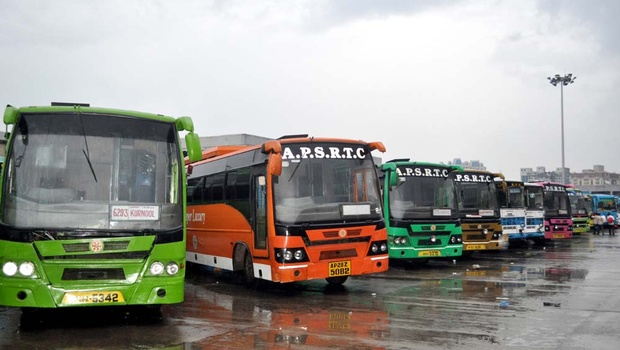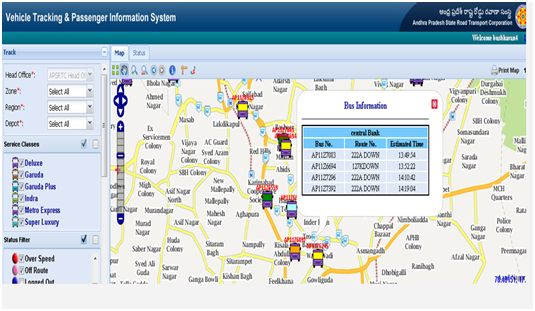Vehicle Tracking & Passenger Information System (VT & PIS) in APSRTC: A Case Study
“Andhra Pradesh State Road Transport Corporation is implementing VT & PIS project to address the critical issue of road congestion by adopting state-of-art technologies and value added services to encourage the usage of bus services instead of individual personal vehicles.”
The origin of Andhra Pradesh State Road Transport Corporation (A.P.S.R.T.C) dates back to June, 1932, when it was first established as NSR-RTD (Nizam State Rail & Road Transport Department), a wing of Nizam State Railway in the erstwhile Hyderabad State, with 27 buses and 166 employees. During the past 80 years, it has registered a steady growth from 27 to 22,713 buses with 773 bus stations, 215 Depots and 1,881 bus shelters. A.P.S.R.T.C under the present name was established on 11th January 1958 in pursuance of the Road Transport Corporations Act 1950.

The Corporation’s buses cover 83.19 lakhs KMs. and carry 136.13 lakhs people to their destinations every day. They connect 23,388 villages to all major towns and cities in A.P which constitutes 95% of Road Transport. A.P.S.R.T.C operates to City and Mofussil areas. The Corporation’s buses also ply to important towns and cities in the neighboring States of Tamilnadu, Karnataka, Maharashtra, Goa, Odisha and Chhattisgarh.
Vehicle Tracking & Passenger Information System (VT&PIS) in Andhra Pradesh State Road Transport Corporation (APSRTC)
Andhra Pradesh State Road Transport Corporation is implementing VT & PIS project to address the critical issue of road congestion by adopting state-of-art technologies and attractive, convenient, comfortable, value added services to encourage the usage of bus services instead of individual personal vehicles. APSRTC aims to bring about this modal shift by improving the perceived image of its services.
The project was awarded to M/s CMC Ltd., Hyderabad. The overall scope of the implementation will consist of design, development, testing, installation, commissioning, training, operations, and management of facilities for a period of five years. This project is planned with Vehicle Tracking System for about 3502 buses, Establishment of Data Center, Control Centers, Passenger Information System, Communication Sub System, Incident and Emergency Management System.
VT & PIS will cover core systems such as Vehicle Tracking System, Real Time Passenger Information System and Central Control Centers. Core technologies include GPRS, GSM, Geographical Positioning System (GPS), Display units and Information & Communication Technologies.
Benefits of introducing VT & PIS
Building intelligence into the transport system brings in the convergence of technologies providing a synergetic transformation in the commuter experience. VT & PIS provides benefits in terms of Reduced waiting time, Increase the accessibility of the system, Increase the passenger base, Reduce the operational costs, Improve traffic efficiency, Reduce traffic congestion by providing actual data for route planning and route rationalization.
Broad objectives of the VT&PIS Project
VT & PIS Project has been implemented in the state transport buses to track and monitor the movement of buses on real time basis and to enable communication of the arrival timings of buses at the bus stops. The system provides Real-time Multi-lingual Passenger Information (Bus Timings, ETA, Promotional Messages, Routes, Bus Stop data etc.) on LCD/LED Display Boards at Bus Stops, Bus Terminals and other identified locations.
The users get instant access to information related to bus schedules, ETA etc., at bus stops and bus terminals through SMS and internet. It has also helped in establishing meaningful instant two-way interaction facility between Driver/Conductor and Control centre. Obtaining online real time information on bus operations and management has become easy. Also, monitoring of breakdowns and the related information has help in effective service delivery.
Functionality of VT & PIS
GPS based Vehicle Tracking Equipment will be installed in the buses identified to be covered under the Project. The service/route in which each bus is operated will be assigned to each Vehicle Tracking device.
The geographical positional coordinates (Latitude and Longitude) are captured by the Vehicle Tracking equipment and transmitted to the Central Data Center at predetermined intervals, through GPRS, for which one SIM card will be installed in each Vehicle Tracking Unit. Based on the route on which the bus travels and its current position, the estimated time of arrival of the bus at all the subsequent stages will be calculated by the application which will be installed in the Data Center. This information will then be sent to the LED/LCD displays concerned, through GPRS for which a SIM card will be installed in the PIS controller of each LED/LCD display Unit. This information is then displayed by the Display Unit. Schematic diagram of the functionality is given hereunder:

Project Coverage
The project is planned to cover about 3,502 buses, the details of which are given hereunder:
a) 1347 Metro buses operating in and around Hyderabad.
b) 239 Metro buses operating in and around Vijayawada.
c) 250 Metro buses operating in and around Visakhapatnam.
d) 50 Metro buses operating in and around Tirupathi.
e) 806 buses operating in Hyderabad-Bengaluru route.
f) 512 buses operating in Vijayawada-Tirupathi/Chennai route.
g) 298 buses operating in Karimnagar – Hyderabad route.
The scope of work consists of Vehicle Tracking System for about 3,502 buses, Establishment of Data Center, 2 Nos. Control Centers in Hyderabad (one for City operations and the other for long distance services), one control centre each in Vijayawada, Viskhapatnam & Tirupathi, Passenger Information System (LCD/LED Displays in Bus Stations/Shelters), on board cameras & in bus destination boards along with voice announcement for 1,476 Metro buses of Hyderabad, Vijayawada, Vishakapatnam and Tirupathi., and maintenance of the entire system for a period of 5 years.
A total of about 189 LED/LCD Display boards are proposed to be installed in Bus Stations/Shelters for displaying Passenger Information like Bus No., Route No., Estimated Time of Arrival(ETA) to the passengers waiting in the bus stations.
PROJECT COMPONENTS:
Vehicle Tracking System (VTS) with real-time connectivity:
Global Positioning System (GPS) based Vehicle Mounted Unit (VMU) will form the core of the VTS. The VMU Unit records and transfer vehicle movement data (Latitude/Longitude coordinates) with time stamp to a central server through GSM/GPRS network.

VTPIS : Solution Perspective
Passenger Information System (PIS):
LCD/LED Display Boards installed at Bus Stations, Bus Shelters and other locations displays real time information of arrival and departure of the Buses at the Bus stops and Bus Stands.
Mobile Application and SMS facility:
Those with smart phones can download a mobile application or check out the APSRTC website to find when the bus will come at their stop. Those who do not have smart phone, can send an SMS to the central call center and a return SMS will be sent to them with the details of bus no, route no and Estimated Time of Arrival(ETA).

Commuter portal: Internet
Commuter: ETA with SMS
In-bus display, Stage Announcement and Recording:
In bus destination boards and voice announcement is provided in city buses for displaying information about the current stop and next stop and voice announcement of the same. This information will be based on the Latitude/Longitude of the bus and the next bus stop. On-board cameras with recording facility in city buses for recording the events/happenings in the buses for later viewing and analysis.

Data center, Control centers:
Data center receives transactional data from device applications into servers hosting VTS, and decision support applications respectively to generate alerts and reports on revenue and schedule parameters aiding in analyzing through a centralized web solution for different users at APSRTC. Two Central Control Rooms established act as live hubs to manage and monitor service related data which will be viewable through a centralized web application on PC’s and LCD Displays.

Depot Application:
Depot Level Applications to support the above systems enable the monitoring and control of the system at the depot level and hence manage the operations in a better way. The current schedules are assigned using the web application at depots.

Conclusion:
With the introduction of VT&PIS Project, APSRTC is now able to manage the entire fleet operations more efficiently through on-line remote access to vehicle positions, speed, breakdown, accident/ incident, etc and make appropriate decisions using the MIS reports that support all levels of management in decision making.
Managing emergency situations has become better by monitoring emergency incident /accident management in real-time. Performance of the bus fleet has improved by monitoring adherence to schedule, route, missed trips, late trips on different routes, break downs and its duration, vehicles offline, accidents – types, impact, losses etc., improper stops at bus stops, driver behavior, deviation in routes, speed violations, at different locations and at different points of time.
Author’s Detail:
G. Jaya Rao, ( E, IT & HRD), Executive Director, APSRTC
Email: gunti.jayarao@gmail.com
[whohit]Vehicle Tracking & Passenger Information System (VT & PIS) in APSRTC: A Case Study [/whohit]




